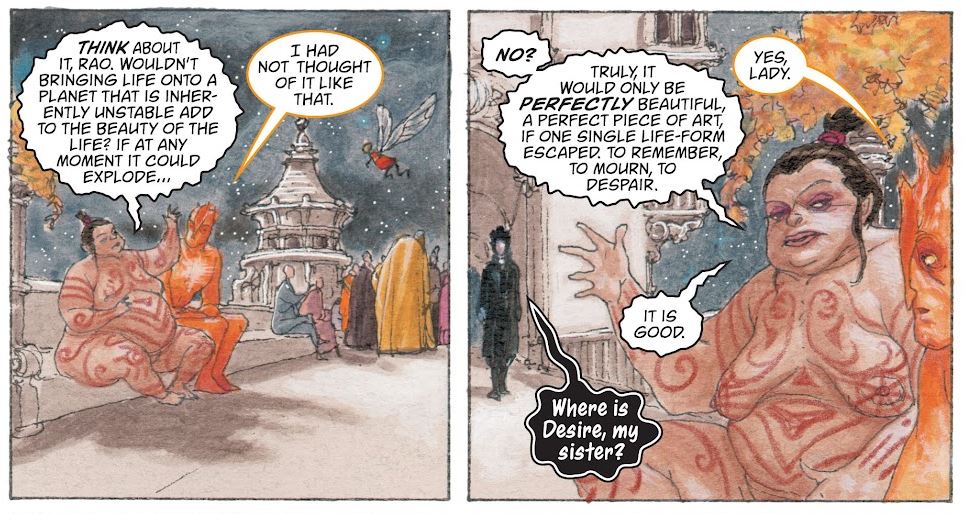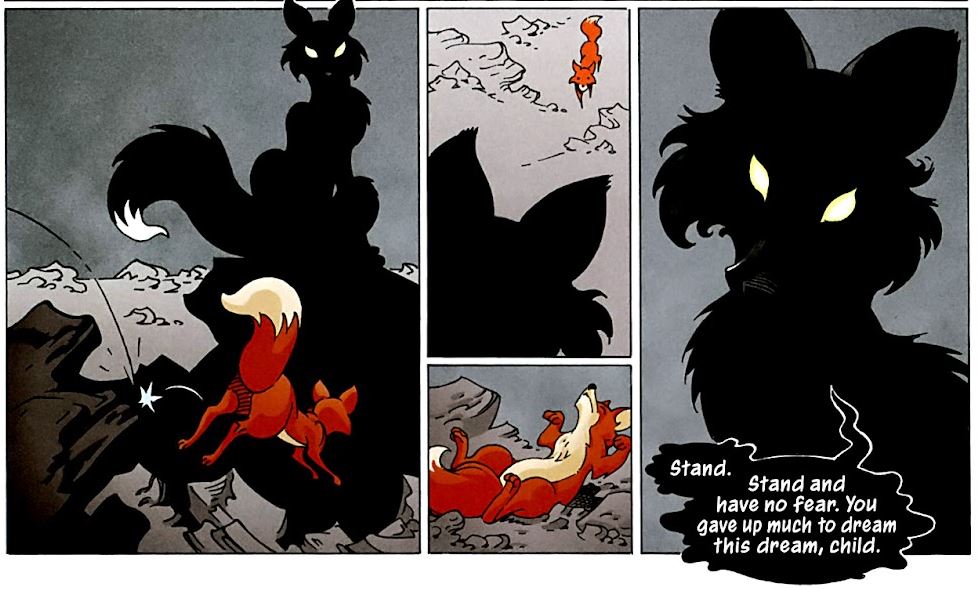With all the talk about the Sandman thanks to his being adapted as a Netflix show, I realized I’d never read Endless Nights. Published in 2003, years after the original 75-issue series by Neil Gaiman ended, Endless Nights is a collection of seven stories. Each one focuses on a different member of the Endless: Death, Dream, Desire, Delirium, Destiny, Destruction, and Despair. As Gaiman recently mentioned in a video about mythology, the Endless are not gods, because gods die when no one remembers them anymore—but the Endless are forever.
Thanks to this blog’s readers, this month I added the hardcover edition of Endless Nights to my Sandman collection, and it was a good read. I would not recommend it as a starting point for getting into Sandman, because it will be confusing to readers who don’t already know the characters and concepts. But for those of us who read and loved the original series, it offers interesting vignettes and wildly creative artwork.
Each of the seven stories employs a different art team, and the pairings of artist with story feel very well-matched. Who but Bill Sienkiewicz could have created such wildly demented illustrations of a team of mentally ill people gathered for a mission to rescue Delirium?
Barron Storey’s non-sequential illustrations for 15 Portraits of Despair are truly disturbing.
Frank Quitely’s painted artwork for the story about Destiny shows a side of the artist I don’t recall seeing before; it’s recognizably Quitely, but with a very different vibe compared to his work with Grant Morrison or on The Authority.
Dave McKean—who did the multi-media covers for the original series—did an amazing job designing this book and all its various title pages and front matter. Todd Klein, the letterer of the original series, also shines by giving each story its own style.
My favorite chapter deals with Dream, also known as Morpheus—the Sandman himself. It’s like so many of the original Gaiman stories in that, yes, there is a “plot”, but it’s more about concepts and characters than action or adventure. Sandman is one of the few comics I enjoy even when there seems to be little more happening than characters talking to each other.
One reason is that Gaiman can achieve more in a couple of panels of dialogue than some writers can do in a single issue or even a whole series. For example, in only two panels of the story about Dream, Gaiman completely recontextualizes the origin of Superman and the planet Krypton.
Despair tells Rao, the star around which Krypton orbited, how artful and poetic it would be to have an unstable planet that would eventually die, and how wonderful it would be to leave only one survivor to despair over its loss. Millions of people have seen Superman as a symbol of hope, despite his tragic origin. By making him a character whose life was meant as an homage to despair, Gaiman adds a layer of poignancy and complexity to Superman and makes it all the more meaningful that he became something else entirely. Pretty heady stuff for two panels of conversation.
Overall, Endless Nights is a little too fragmentary to earn a place in my all-time favorite Sandman books. The story about Destruction, for example, never really gets explained and feels like an unfinished tale. But competition is stiff when it comes to Sandman favorites. The story arcs Season of Mists (which led directly to the masterful Mike Carey series Lucifer) and The Kindly Ones are epic in scope, and the original series is loaded with gorgeously written and drawn single-issue stories. The two limited series starring Death are also masterworks (The High Cost of Living and The Time of Your Life, now collected in a single volume).
But my all-time favorite is The Dream Hunters. It first appeared as a prose novel with incredible painted illustrations by Yoshitaka Amano, then was re-imagined as a four-issue comic book drawn by P. Craig Russell—whose work also appears in Endless Nights. The Dream Hunters is presented as an ancient tale from Japanese mythology, but Gaiman just made it up! It tells the story of a fox who fell in love with a Buddhist monk, and the dramatic sacrifices they made for each other. I’ve read it many times, and I don’t think I ever made it through either version without crying. If anyone asks me where to start with Sandman, that’s the story I recommend. There’s now an inexpensive ebook edition along with paperback and hardcover collections.
Still, Endless Nights is an artistic addition to the Sandman canon, and well worth exploring for fans of the series. You can find it in hardcover or paperback editions, or snag a $4 ebook of a more recent edition. A big Thank You to the readers of this blog for helping me add this book to my Sandman collection.








Pingback: Ten Heroines Who Don’t Look or Pose Like Penthouse Pets | Mars Will Send No More
Pingback: big box of comics: The Sandman — Overture | Mars Will Send No More
Pingback: Big Box of Comics: Endings and Beginnings in Utopia | Mars Will Send No More